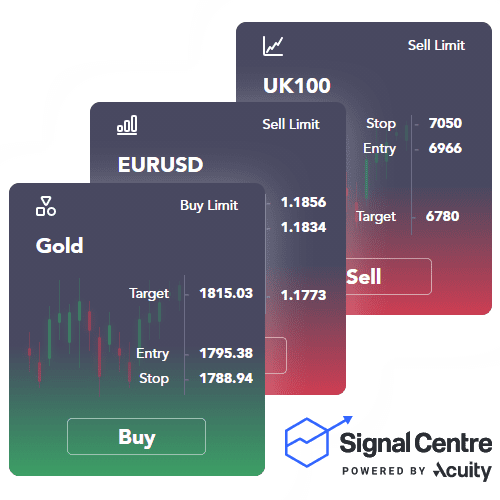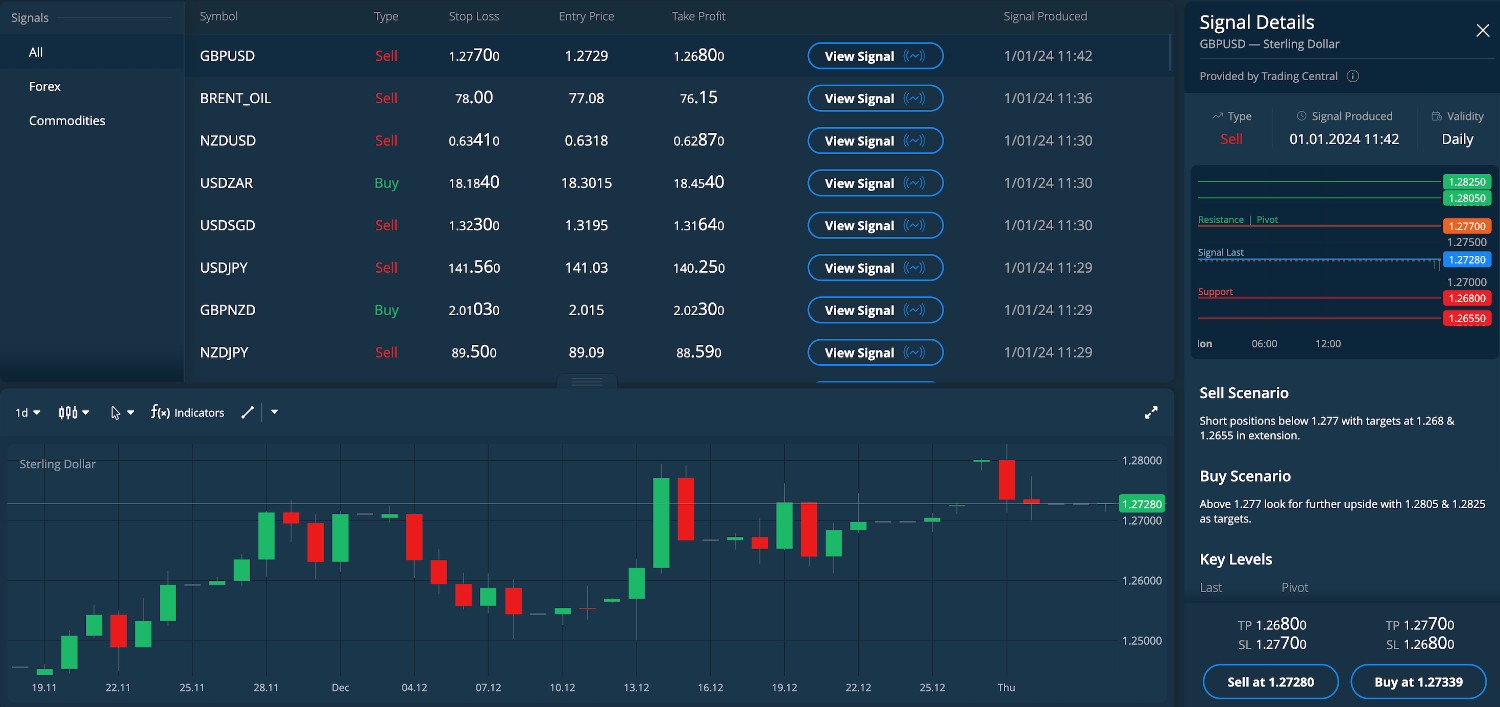Best Trading Signal Providers In 2025



Available from a range of brokers and third-party providers, trading signals are an increasingly popular tool, providing a prompt to buy or sell a particular asset.
Explore the best signal providers following our hands-on tests. We also explain how to choose signals and how you can incorporate them into your trading strategy to improve your understanding.
Best Brokers For Trading Signals 2025
These 6 brokers with signals achieved the highest overall ratings following our latest in-depth reviews. They offer a large pool of signals with clear performance metrics, making them stand-out options:
Why Are These The Best Providers For Trading Signals?
Here’s a concise summary of why we believe these brokers are best for trading signals:
- NinjaTrader is the best signal provider in 2025 - NinjaTrader is a US-headquartered and regulated brokerage that specializes in futures trading. There are three pricing plans to suit different needs and budgets, as well as ultra-low margins on popular contracts. The brand's award-winning charting software and trading platform also offers a high-degree of customization and superb technical analysis features.
- Moomoo - Moomoo is an SEC-regulated app-based investment platform that offers a straightforward and affordable way to invest in Chinese, Hong Kong, Singaporean, Australian and US stocks, ETFs and other assets. Margin trading is available and the brand offers a zero-deposit account as well as several bonuses.
- Videforex - Videforex stands out for its simple, high/low daily trading signals for forex, crypto and other markets. Before we could use them in our tests, we had to verify our email address, then go into Notifications and the Email Settings area of the client dashboard, and toggle daily trading signals on. Once activated, Videforex sends frequent ideas. In our view, they best serve beginner to intermediate traders looking for a steer on liquid markets where there’s short-term price action, but it’s still worth running your own analysis – the Videforex charting package can help here with its over 70 technical indicators.
- xChief - During testing, xChief's MetaQuotes Signals access stood out, letting traders automatically copy top performers or offer their own signals. PAMM accounts allow following experienced traders, while MQL4/5 support enables custom indicators and EAs. The platform’s signals are flexible, practical, and suited for both automated and hands-on strategies.
- Bubinga - In our tests, Bubinga’s Trading Room delivers analyst-generated signals that can highlight potential setups, but they aren’t automated, so every trade must be entered manually, while the workflow felt clunky and slow in use.
- Optimus Futures - Optimus Futures delivers strong signal and alert capabilities, with 50+ built-in indicators, volume and TPO analysis, plus TradingView alert integration and SignalStack for automated trade execution.
How Safe Are These Trading Signal Providers?
Discover the reliability of the top real-time trading signal providers and how they safeguard your funds:
| Broker | Trust Rating | Guaranteed Stop Loss | Negative Balance Protection | Segregated Accounts |
|---|---|---|---|---|
| NinjaTrader | ✘ | ✘ | ✘ | |
| Moomoo | ✘ | ✘ | ✔ | |
| Videforex | ✔ | ✔ | ✘ | |
| xChief | ✘ | ✘ | ✔ | |
| Bubinga | ✘ | ✘ | ✘ | |
| Optimus Futures | ✘ | ✘ | ✔ |
Compare Mobile Trading Signals
See how these brokers measure up for mobile trading signals:
| Broker | Mobile Apps | iOS Rating | Android Rating | Smart Watch App |
|---|---|---|---|---|
| NinjaTrader | iOS & Android | ✘ | ||
| Moomoo | Yes (iOS & Android) | ✘ | ||
| Videforex | Android | ✘ | ||
| xChief | iOS & Android | ✘ | ||
| Bubinga | - | - | - | ✘ |
| Optimus Futures | iOS & Android | ✘ |
Are The Top Automated Trade Signal Providers Good For Beginners?
Beginners should use trading signals alongside other key tools for new traders:
| Broker | Demo Account | Minimum Deposit | Minimum Trade | Education Rating | Support Rating |
|---|---|---|---|---|---|
| NinjaTrader | ✔ | $0 | 0.01 Lots | ||
| Moomoo | ✔ | $0 | $0 | ||
| Videforex | ✔ | $250 | $0.01 | ||
| xChief | ✔ | $10 | 0.01 Lots | ||
| Bubinga | ✔ | $10 | $1 | ||
| Optimus Futures | ✔ | $500 | $50 |
Compare The Ratings Of Top Signal Trading Brokers
Discover how the leading brokers for trading signals rate across key areas after our in-depth evaluations:
| Broker | Trust | Platforms | Assets | Mobile | Fees | Accounts | Research | Education | Support |
|---|---|---|---|---|---|---|---|---|---|
| NinjaTrader | |||||||||
| Moomoo | |||||||||
| Videforex | |||||||||
| xChief | |||||||||
| Bubinga | - | ||||||||
| Optimus Futures |
Compare Trading Fees
Trading costs, including mark-ups on signals, can add up fast - here is how the top providers compare:
| Broker | Cost Rating | Fixed Spreads | Inactivity Fee |
|---|---|---|---|
| NinjaTrader | ✘ | $25 | |
| Moomoo | ✘ | $0 | |
| Videforex | ✘ | $10 | |
| xChief | ✘ | - | |
| Bubinga | ✘ | $0 | |
| Optimus Futures | ✘ | $0 |
How Popular Are These Brokers With Trading Signals?
Many traders favor signal brokers with the highest number of registered clients:
| Broker | Popularity |
|---|---|
| Moomoo | |
| NinjaTrader | |
| xChief | |
| Videforex |
Why Use Trading Signals From NinjaTrader?
"NinjaTrader continues to meet the demands of active futures traders looking for low fees and premium analysis tools. The platform hosts top-rate charting features including hundreds of indicators and 10+ chart types."
Tobias Robinson, Reviewer
NinjaTrader Quick Facts
| Demo Account | Yes |
|---|---|
| Instruments | Forex, Stocks, Options, Commodities, Futures, Crypto |
| Regulator | NFA, CFTC |
| Platforms | NinjaTrader Desktop, Web & Mobile, eSignal |
| Minimum Deposit | $0 |
| Minimum Trade | 0.01 Lots |
| Leverage | 1:50 |
| Account Currencies | USD |
Pros
- NinjaTrader continues to deliver comprehensive charting software for active day traders with bespoke technical indicators and widgets
- Traders can get free platform access and trade simulation capabilities in the unlimited demo
- Low fees are offered, with $50 day trading margins & commissions from $.09 per micro contract
Cons
- There is a withdrawal fee on some funding methods
- The premium platform tools come with an extra charge
- Non forex and futures trading requires signing up with partner brokers
Why Use Trading Signals From Moomoo?
"Moomoo remains an excellent choice for new and intermediate stock traders who want to build a diverse investment portfolio. What really stands out is the broker's user-friendly app and the low trading fees."
Jemma Grist, Reviewer
Moomoo Quick Facts
| Demo Account | Yes |
|---|---|
| Instruments | Stocks, Options, ETFs, ADRs, OTCs |
| Regulator | SEC, FINRA, MAS, ASIC, SFC |
| Platforms | Desktop Platform, Mobile App |
| Minimum Deposit | $0 |
| Minimum Trade | $0 |
| Leverage | 1:2 |
| Account Currencies | USD, HKD, SGD |
Pros
- Moomoo's analytics and insights are impressive and detailed compared to other brands
- There is no minimum deposit requirement making the broker accessible for beginners
- There are reduced options contract fees from $0.65 to $0
Cons
- There is no phone or live chat support - common options at most other brokers
- There is no negative balance protection, which is a common safety feature at top-tier-regulated brokers
- It's a shame that there is no 2 factor authentication (2FA), despite the other security features on offer
Why Use Trading Signals From Videforex?
"Videforex will serve traders looking for an easy-to-use platform to speculate on the direction of popular financial markets through binaries, especially cryptos and stocks, with dozens of assets added. The integration of TradingView charts also caters to technical traders. However, it requires a trade-off – no regulatory oversight, making it a risky choice. "
William Berg, Reviewer
Videforex Quick Facts
| Demo Account | Yes |
|---|---|
| Instruments | Binary Options, CFDs, Forex, Indices, Commodities, Crypto |
| Platforms | TradingView |
| Minimum Deposit | $250 |
| Minimum Trade | $0.01 |
| Leverage | 1:2000 |
| Account Currencies | USD, EUR, GBP, AUD, RUB |
Pros
- With the addition of over 60 new assets, Videforex now gives traders access to in-demand crypto (TON, ARB, PEPE, SHIB), top-performing tech stocks (Tesla, Meta, Nvidia, Amazon), and a more diverse FX portfolio (THB, ZAR, and MXN).
- Traders can earn up to 98% payouts on 150+ assets with the broker’s binary options, bringing it in line with competitors like IQCent.
- Videforex regularly runs trading contests, offering practice opportunities and cash prizes to beginners and experienced traders, with position sizes from just ¢0.01.
Cons
- The client terminal needs improvements based on our latest tests, sporting sometimes slow and unresponsive widgets which could dampen the experience for day traders.
- Videforex lacks authorization from a trusted regulator, meaning traders may receive little to zero safeguards like segregated client accounts.
- The absence of any educational tools is a serious drawback for newer traders who can find blogs, videos and live trading sessions at category leaders.
Why Use Trading Signals From xChief?
"xChief continues to prove popular with investors looking to trade highly leveraged CFDs on the popular MetaTrader platforms. The broker's rebate scheme and investment accounts will particularly appeal to seasoned traders. However, the lack of top-tier regulatory oversight is a major drawback."
William Berg, Reviewer
xChief Quick Facts
| Demo Account | Yes |
|---|---|
| Instruments | CFDs, Forex, Metals, Commodities, Stocks, Indices |
| Regulator | ASIC |
| Platforms | MT4, MT5 |
| Minimum Deposit | $10 |
| Minimum Trade | 0.01 Lots |
| Leverage | 1:1000 |
| Account Currencies | USD, EUR, GBP, JPY, CHF |
Pros
- Traders can access a copy trading solution via the MetaQuotes Signals service
- xChief delivers a high-quality day trading environment via the MT4 and MT5 platforms, with market-leading charts, indicators and tools
- The broker offers several account types to suit different traders, including a Cent account for beginners and pro-level hedging/netting accounts
Cons
- xChief is an offshore broker with weak regulatory oversight from the VFSC, so traders will receive limited safeguards
- The total range of 150+ assets is much lower than most competitors who typically offer hundreds
- Fees and minimums are imposed on most withdrawal methods, including a €60 minimum for SWIFT bank transfers
Why Use Trading Signals From Bubinga?
"With an account that takes under 2 minutes to create, trade sizes from $1, and popular assets like U.S. technology stocks and key currency pairs, Bubinga suits aspiring traders looking to make simple high/low trades on well-known assets."
Christian Harris, Reviewer
Bubinga Quick Facts
| Demo Account | Yes |
|---|---|
| Instruments | Binary Options, Forex, Stocks, Indices, Commodities, Crypto |
| Platforms | Own, TradingView |
| Minimum Deposit | $10 |
| Minimum Trade | $1 |
| Account Currencies | USD, EUR, JPY, KRW |
Pros
- Bubinga’s order execution speed is decent. During active trading, the platform handled quick entries and exits without noticeable lag. For day traders, this responsiveness is important for catching tight expiry windows, which start from 1 minute.
- Bubinga’s web platform has been built with beginners in mind – no cluttered interface – just a simple chart and basic settings to configure the expiry time, stake and binary direction.
- Bubinga stands out from most competitors by offering Tradeback, which repays part of the previous week’s trading losses, with payments made to accounts every Tuesday.
Cons
- Withdrawal limits on lower-tier accounts can be frustrating. When you start, you might find it hard to cash out more than a small amount at once, which slows your access to your profits. It pushes you to keep funding your account beyond what you might feel comfortable with.
- The platform’s limited research tools means you have to juggle multiple apps or sites for market info. Not having live news or market analysis inside the platform makes it harder to react quickly.
- The lack of regulation at Bubinga is a concern. Without oversight from a trusted body in DayTrading.com’s regulator tracker, there’s always a risk that your funds won’t be fully protected.
Why Use Trading Signals From Optimus Futures?
"Optimus Futures is best for active futures day traders who want low per-contract costs and the flexibility to build a custom trading setup across platforms like Optimus Flow, TradingView, and Sierra Chart. Its fast order-routing, low day trading margins, depth-of-market and footprint analysis tools, plus the ability to select your own clearing firm, make it especially suited to high-volume traders focused on U.S. and global futures markets."
Christian Harris, Reviewer
Optimus Futures Quick Facts
| Demo Account | Yes |
|---|---|
| Instruments | Futures on Indices, Metals, Energies, Softs, Bonds, Cryptos, Options on Futures, Event Contracts |
| Regulator | NFA, CFTC |
| Platforms | Optimus Flow, Optimus Web, MT5, TradingView |
| Minimum Deposit | $500 |
| Minimum Trade | $50 |
| Account Currencies | USD |
Pros
- Futures commission rates are competitive, and there’s transparent access to trading on major exchanges, while the firm's fee calculator makes it a breeze to estimate trading costs before placing orders, helping to avoid surprises.
- Optimus Futures has expanded its suite of software, with a variety of futures trading platforms, including its own Optimus Flow, CQG, MetaTrader 5, and TradingView, making it easy to find the right fit for charting, order management, and execution.
- Optimus Futures stands out with ultra-low day trading margins on micro futures, starting at just $50 per contract and a $100 minimum balance, giving small accounts serious buying power.
Cons
- There's no true 'all-in-one' account management dashboard - key functions like risk settings, software downloads, and subscriptions are split across different sections or platforms, so it required extra digging to set everything up during testing.
- There are limited payment options and no toll-free numbers for international support, while withdrawals cost $20 to $60, potentially making frequent withdrawals costly for active traders.
- Live chat support is handled entirely by a bot, so despite several attempts in our tests, it wasn't possible to get access to a human agent, which can be frustrating when urgent or complex questions arise.
Alternatively, for traders who want signals that can be used with any broker, these 3 independent providers really impressed our experts out of the 10+ firms we’ve put through their paces:
Best Independent Signal Providers



How To Choose A Signal Provider
Choosing a signal provider can be challenging, especially with the level of misinformation out there. That’s why we, and you, should consider the following factors when selecting a provider:
Safety
Prioritize the safety and reliability of signal providers as you would when choosing an online broker.
We’ve found that not all signal providers have the same expertise, and many firms lack regulation from trusted bodies like the UK Financial Conduct Authority (FCA) or Australian Securities & Investments Commission (ASIC), making it challenging to identify trustworthy companies.
The rationale behind the limited regulation of signal providers stems from their lack of access to customer portfolios. Often operating anonymously, these services do not establish a conventional customer/provider relationship, exempting them from being classified as financial services providers similar to brokerages.
Still, the absence of regulatory oversight increases the risk of falling victim to scams, with instances of commission scammers targeting investors being reported.
For example, several thousand young traders subscribed to a WhatsApp group for regular messages with updates on assets and trading opportunities, many of whom lost considerable sums.
- ThinkMarkets is a trusted broker that provides access to Signal Centre, which stands out as a regulated signalling platform under the UK’s FCA.

Performance
Evaluate signal providers based on their historical performance.
The top providers publish reports highlighting signals’ success over a period. Consider elements such as how many signals were published, which assets the provider has distributed the maximum number of accurate prompts, and how profitable these ideas have been.
Importantly, we recommend reviewing historical performance over a longer period, for example a year, as unexpected price volatility may blur an outlook.
Be careful, though, as some providers may doctor their results to try and entice new customers. See if reviews match up to the claims made by the firm to be safe.
- FOREX.com excels with its user-friendly dashboard that shows the performance of signals with a hit rate out of 10.

Cost
While the most affordable trading signals might be appealing, you must recognize that cost often correlates with quality.
We’ve observed that free signals, while not always the case, frequently originate from untrustworthy sources with hidden agendas.
Many signal providers opt for a monthly subscription fee rather than a one-time (lifetime) usage charge. These fees can range from $10 per month to exceeding $500. Some brokers, however, may cover these costs for retail traders.
We recommend checking the forecasted (or historical) performance of a provider and apply it to your account capital to see how much you will be able to afford and whether a more expensive service will be worth it.
- IG is a broker I personally use and it offers complimentary trading signals on forex, index and commodity markets to registered clients. There is no extra cost to act on signals.
Markets
Choose signals based on your preferred market, trading session, or even diversify across multiple markets to align with your trading strategies and risk preferences.
Signals can offer insights into potential trading opportunities in individual stocks, forex, cryptocurrencies like Bitcoin and Ethereum, commodities such as gold and oil, and derivatives like CFDs.
- City Index offers a top-rate solution called SMART Signals, which scans 36 global markets across hundreds of thousands of data points to find daily trading opportunities.
Alerts
Select a provider that distributes trading signals through a convenient contact method, such as SMS.
If you are happy receiving signals through whatever means, then this may not be a massive issue. However, some traders may not want to provide their email address or mobile number to a signals provider, instead preferring another contact method.
If you are looking for maximum ease of use or automated execution, filter through trading signals providers by requiring that they integrate with your trading platform. This can be done directly or through an API offered by the firm, though this may require a little extra work on your end to set it up.
5 Tips For Choosing Signals
Once you have chosen a broker with trading signals or an independent platform, consider our 5 top tips when choosing individual signals:
- Look for signals with a proven history of account growth, as this could greatly impact the success of your trades.
- Gain a comprehensive understanding of the methodology behind the signals to ensure they align with your trading goals and risk tolerance.
- Evaluate how the signals manage risk by considering the risk-reward ratio, stop-loss mechanisms, and overall risk management strategies embedded within the signals to safeguard your capital.
- Determine if the signals provide real-time analysis, as signals that offer current and relevant information will be more valuable for making informed decisions.
- Assess whether the signals can be customized to suit your trading preferences and if they’re compatible with your chosen trading platform.
What Are Trading Signals?
Trading signals are indications or alerts generated by either human analysts or automated systems (using algorithms or AI) that suggest potential entry or exit points for trading financial assets.
Signals provide quick insights into potential market opportunities, allowing you to act promptly on identified signals without spending extensive hours studying charts and market data.
Signals are usually based on technical analysis, fundamental analysis, or a combination of both, aiming to guide you in making informed decisions.
They can be derived from various sources, such as price patterns, moving averages, volume trends, market sentiment, economic indicators, or specific mathematical algorithms.
Trading signals aim to identify opportunities where the probability of a successful trade is deemed higher based on historical patterns or current market conditions.
These signals typically specify:
- Asset & Timeframe: The asset (stocks, forex, cryptocurrencies, etc.) and timeframe (daily, hourly, etc.) the signal applies to.
- Entry Points: Suggested levels or conditions at which to enter a trade (buy or sell).
- Exit Points: Indications of when to close a trade to secure profits or limit potential losses (take-profit or stop-loss levels).

How Do Trading Signals Work?
Here’s a breakdown of how trading signals typically function:
- Data Collection & Analysis: Signal providers gather and analyze market data from various sources. This includes price movements, volume trends, chart patterns, moving averages, support and resistance levels, and possibly news or fundamental indicators related to specific assets or markets.
- Signal Generation: Based on the analysis, predefined criteria, or algorithms, the system generates signals. These criteria could involve specific technical indicators crossing certain thresholds, trend confirmations, or patterns emerging on charts (e.g., head and shoulders patterns, moving average crossovers).
- Delivery: Signals are then distributed to signal subscribers through various means. This could be via email, SMS, mobile apps, or within trading platforms. Some signal providers offer real-time updates, while others might offer periodic updates based on market conditions or preset time intervals.
- Interpretation: When receiving these signals you should evaluate them alongside your own strategies, risk tolerance, and market understanding. You should assess the credibility and relevance of the signals before deciding whether to act upon them.
- Execution Of Trades: Based on the received signals and your own assessment, you can execute trades or not. Signals often specify entry points (buy/sell), exit points (take-profit, stop-loss), and sometimes even recommended position sizes.
- Continuous Monitoring & Adjustment: You should monitor the market and adjust your positions based on how the market evolves. This includes managing trades by adjusting stop-loss levels, taking profits, or exiting positions if market conditions change.
It’s important to note that while trading signals can be valuable tools, they’re not foolproof. Market conditions can change quickly, leading to unexpected results.
Treat signals as a supplementary tool rather than an absolute directive.
Bottom Line
Utilizing trading signals can offer a beneficial avenue for capitalizing on gains, but it’s crucial to acknowledge that profits aren’t guaranteed.
These signals amalgamate technical, fundamental, and quantitative analyses to predict and forecast market or asset movements. Yet, these forecasts don’t always materialize, necessitating robust risk management systems. Furthermore, numerous scammers target inexperienced traders with misleading signals.
Nevertheless, following our guidelines above can help you get started with trusted signals providers and minimize associated risks.
FAQ
Are Trading Signals Legal?
Yes, trading signals are generally legal. They are essentially market analyses or recommendations provided by individuals, analysts, or automated systems, which are legal means of conveying information and strategies to assist you in making informed decisions.
However, the legality might vary based on the region and compliance with financial regulations governing investment advice and services.
How Do I Get The Most Out Of Trading Signals?
Generally, you can filter the signals that you receive with a large number of variables. For example, you could specify the assets for which you are notified of opportunities.
You can also limit the timeframes over which the signals should require a position to be open. Shorter-term day traders and scalpers may request one or five-minute signals, while others may prefer hourly or eight-hour chart notifications.
Who Gives The Best Trading Signals?
Determining the ‘best’ trading signals provider is subjective and can vary based on your individual preferences, accuracy, and compatibility with trading strategies.
Some well-regarded sources include professional analysts, reputable financial institutions, and established trading signal platforms with a track record of accuracy and reliability.
Researching and trialling various sources will help you to identify the most profitable signals for your specific trading styles and goals.
Why Do Providers Give Free Signals?
Signal providers often offer free signals to attract followers, build credibility, or as a marketing strategy to promote premium services or products.
It’s a way for signal providers to showcase their expertise, gain a larger audience, and potentially convert free users into paying subscribers for more advanced or exclusive signal offerings.
Are Trading Signals Scams?
In our experience, the majority of trading signals are either junk or scams. However, a few good ones try to help people understand trading better.
Trading signals aren’t inherently bad and often come from technical analysis, market data, or ‘expert’ opinions. The goal is to help you make smarter trading decisions.
However, the problem lies with a lot of signal providers (mainly forex) who make unrealistic promises. They might guarantee huge profits or claim an unrealistically high success rate. These tactics are often used to lure unsuspecting traders into expensive subscriptions.
To protect yourself, always do your due diligence. Research the signal provider, verify their track record, and be wary of claims that seem too good to be true.
What Are The Benefits Of Using Trading Signals?
You can use signals to enhance decision-making and save time through pre-analyzed market insights, complementing existing trading strategies.
You can access expert analyses, remove emotional biases, and use signals as a learning opportunity to improve strategies and gain insights into market dynamics and technical analysis.
What Are The Risks Of Using Trading Signals?
Using trading signals carries risks, including potential errors or inefficiencies, and reliance on historical data may not adapt well to sudden market shifts or unexpected events.
Additionally, subscription costs, overdependence without understanding underlying analysis, and lack of customization to individual preferences or trading styles can further pose challenges.
Should I Act On A Trading Signal?
When you retrieve a trading signal, it is up to you whether you follow through with the suggestion.
Some traders might assess the perceived risk (usually included in the notification) as too high or have carried out their own fundamental or technical analysis that leads them to believe the signal may not be successful.
If you have unwavering faith in the signals that are sent to you and use a program that integrates with your platform, you can automate your response. This will mean that there is less delay between the opportunity being recognized and the position being opened, likely improving the extent of any profits that are made.
However, if you implement this, you will not be able to reject signals on a case-by-case basis.
Article Sources
The writing and editorial team at DayTrading.com use credible sources to support their work. These include government agencies, white papers, research institutes, and engagement with industry professionals. Content is written free from bias and is fact-checked where appropriate. Learn more about why you can trust DayTrading.com





